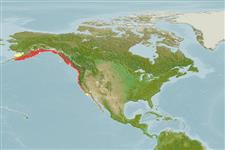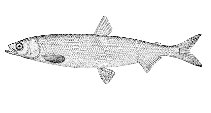Adicionar as suas observações no Fish Watcher
| Native range | All suitable habitat | Point map | Year 2050 |

|
| This map was computer-generated and has not yet been reviewed. |
| Hypomesus pretiosus AquaMaps Data sources: GBIF OBIS |
Adicionar o seu Fotografias e vídeos
Pictures | Videos | Imagem do GoogleHypomesus pretiosus
Picture by Bull. U.S. Bur. Fish.
Pictures | Videos | Imagem do GoogleHypomesus pretiosus
Picture by Bull. U.S. Bur. Fish.
Canada country information
Common names:
Day smelt, Kiina, Qaian
Occurrence: native
Salinity: brackish
Abundance: common (usually seen) | Ref: Clemens, W.A. and G.V. Wilby, 1961
Importance: commercial | Ref: Coker, G.A., C.B. Portt and C.K. Minns, 2001
Aquaculture: | Ref:
Regulations: restricted | Ref: Canadian Department of Fisheries and Oceans, 1995
Uses: live export: yes;
Comments: Recorded from the Pacific coast (Ref. 6885). In lower Fraser River and Pitt Lake, BC (Ref. 112251). Also Ref. 4925, 95148, 95155. In range Ref. 2850.
National Checklist:
Country Information: https://www.cia.gov/library/publications/resources/the-world-factbook/geos/ca.html
National Fisheries Authority: http://www.ncr.dfo.ca/home_e.htm
Occurrences: Occurrences Point map
Main Ref: Hart, J.L., 1973
National Database:
Occurrence: native
Salinity: brackish
Abundance: common (usually seen) | Ref: Clemens, W.A. and G.V. Wilby, 1961
Importance: commercial | Ref: Coker, G.A., C.B. Portt and C.K. Minns, 2001
Aquaculture: | Ref:
Regulations: restricted | Ref: Canadian Department of Fisheries and Oceans, 1995
Uses: live export: yes;
Comments: Recorded from the Pacific coast (Ref. 6885). In lower Fraser River and Pitt Lake, BC (Ref. 112251). Also Ref. 4925, 95148, 95155. In range Ref. 2850.
National Checklist:
Country Information: https://www.cia.gov/library/publications/resources/the-world-factbook/geos/ca.html
National Fisheries Authority: http://www.ncr.dfo.ca/home_e.htm
Occurrences: Occurrences Point map
Main Ref: Hart, J.L., 1973
National Database:
Common names from other countries
Classificação / Names Nomes comuns | Sinónimos | Catalog of Fishes(Género, Espécies) | ITIS | CoL | WoRMS | Cloffa
> Osmeriformes (Freshwater smelts) > Osmeridae (Smelts)
Etymology: Hypomesus: Greek, hypo = under + Greek,mesos = a half (Ref. 45335).
More on author: Girard.
Etymology: Hypomesus: Greek, hypo = under + Greek,mesos = a half (Ref. 45335).
More on author: Girard.
Environment: milieu / climate zone / depth range / distribution range Ecologia
marinhas; estuarina bentopelágico. Temperate; 61°N - 33°N, 163°W - 117°W
Distribuição Países | Áreas FAO | Ecossistemas | Ocorrências | Point map | Introduções | Faunafri
Eastern Pacific: Prince William Sound, Gulf of Alaska to Long Beach, southern California, USA. Reports from the western Pacific are misidentifications of Hypomesus japonicus.
Length at first maturity / Tamanho / Peso / Idade
Maturity: Lm ?, range 9 - ? cm
Max length : 30.5 cm TL macho/indeterminado; (Ref. 6885); common length : 15.0 cm TL macho/indeterminado; (Ref. 12193); Idade máx. registada: 5 anos (Ref. 72502)
Max length : 30.5 cm TL macho/indeterminado; (Ref. 6885); common length : 15.0 cm TL macho/indeterminado; (Ref. 12193); Idade máx. registada: 5 anos (Ref. 72502)
Descrição breve Chaves de identificação | Morfologia | Morfometria
Espinhos dorsais (total) : 0; Raios dorsais moles (total) : 9 - 11; Espinhos anais: 0; Raios anais moles: 12 - 17; Vértebras: 64 - 67. Vomer small, without posterior process; periphery of glossohyal bone with single row of blunt teeth, a few teeth located irregularly at center of distal region; base of adipose fin less than 20% of head length; eye small; adipose eyelid well developed (Ref. 33312). Distinguished by its midlateral scale count of 66 to 73 and the presence of 4 to 7 pyloric caeca (Ref. 27547). Lateral line short and incomplete, reaching about to tip of pectorals (Ref. 27547). Adipose sickle-shaped; pectorals small; pelvic fins originating behind or below dorsal origin (Ref. 6885). Light olive green to brownish on back, sides and belly silvery and iridescent with a bright reflecting band along the side in living specimens; males show more golden hues than females during spawning season (Ref. 6885). Branchiostegal rays: 7-8 (Ref. 35792).
Individuals 3.5 cm may ascend rivers, presumably returning to the sea shortly after (Ref. 27547). Presumably young move offshore and reappear inshore as mature adults (Ref. 27547). At sea, they feed on small crustaceans, worms and jellyfish, as well as larval fishes (Ref. 6885, 10276). Females reach age 3, males age 2 (Ref. 27547). Oviparous, with demersal eggs and planktonic larvae (Ref. 35792). Eggs are laid on beaches with heavy surf action (Ref. 33312).
Life cycle and mating behavior Maturidade | Reprodução | Desova | Ovos | Fecundidade | Larvas
Schools approach the beach to spawn, usually with the females appearing a few days before the males. At spawning, large numbers of males mill about near the edge of the surf. When a female is seen, numbers of males pursue her and try to get into spawning position. If she swims to deeper water, the males desert her. 1 to 5 males swim parallel to and slightly behind a ripe female. The males press against the female and as they reach water 2.5 to 5 cm deep, the fish bend and vibrate, releasing eggs and sperm, then retreat to deeper water. The spawning act may be repeated on several successive waves. Wave action buries the eggs, usually to a depth of 2.5 to10 cm but sometimes to as deep as 30 cm (Ref. 27547).
Referência principal
Upload your references | Referências | Coordenador | Colaboradores
Saruwatari, T., J.A. López and T.W. Pietsch, 1997. A revision of the ormerid genus Hypomesus Gill (Teleostei: Salmoniformes), with a description of a new species from the southern Kuril Islands. Species Diversity 2:59-82. (Ref. 33312)
Ameaça para o homem
Harmless
Utilização humana
Pescarias: espécies comerciais; peixe desportivo: sim
FAO(pescarias: produção; publication : search) | FishSource | Sea Around Us
Mais informação
Population dynamics
Parâmetros de crescimento
Max. ages / sizes
Length-weight rel.
Length-length rel.
Frequência de comprimento
Mass conversion
Recrutamento
Abundância
Parâmetros de crescimento
Max. ages / sizes
Length-weight rel.
Length-length rel.
Frequência de comprimento
Mass conversion
Recrutamento
Abundância
Life cycle
Reprodução
Maturidade
Fecundidade
Desova
Spawning aggregations
Ovos
Desenvolvimento dos ovos
Larvas
Dinâmica larvar
Reprodução
Maturidade
Fecundidade
Desova
Spawning aggregations
Ovos
Desenvolvimento dos ovos
Larvas
Dinâmica larvar
Anatomy
Área branquial
Brain
Otolith
Área branquial
Brain
Otolith
Physiology
Body composition
Nutrients
Consumo de oxigénio
Tipo de natação
Velocidade de natação
Visual pigments
Fish sound
Diseases & Parasites
Toxicity (LC50s)
Body composition
Nutrients
Consumo de oxigénio
Tipo de natação
Velocidade de natação
Visual pigments
Fish sound
Diseases & Parasites
Toxicity (LC50s)
Human related
Aquaculture systems
Perfis para aquacultura
Estirpes
Ciguatera cases
Stamps, coins, misc.
Aquaculture systems
Perfis para aquacultura
Estirpes
Ciguatera cases
Stamps, coins, misc.
Ferramentas
E-book | Guia de campo | Ferramenta auxiliar de frequências de comprimento | Ferramenta sobre a história de vida | Mapa dos pontos | Classification Tree
| Catch-MSY |
Relatórios especiais
Descarregue XML
Fontes da internet
Aquatic Commons | BHL | Cloffa | Websites from users | Consultar FishWatcher | CISTI | Catalog of Fishes(Género, Espécies) | DiscoverLife | ECOTOX | Faunafri | Fishtrace | GenBank(genoma, nucleotídeo) | GloBI | GOBASE | | Google Books | Google Scholar | Google | IGFA World Record | MitoFish | Otolith Atlas of Taiwan Fishes | PubMed | Reef Life Survey | Scirus | SeaLifeBase | Árvore da vida | Wikipedia(ir para, procurar) | World Records Freshwater Fishing | Registo zoológico
Estimates based on models
Preferred temperature (Ref. 115969): 7.5 - 11.8, mean 8.6 (based on 58 cells).
Phylogenetic diversity index (Ref. 82804): PD50 = 0.5313 [Uniqueness, from 0.5 = low to 2.0 = high].
Bayesian length-weight: a=0.00372 (0.00178 - 0.00775), b=3.17 (2.99 - 3.35), in cm Total Length, based on LWR estimates for this (Sub)family-body shape (Ref. 93245).
Nível Trófico (Ref. 69278): 3.4 ±0.41 se; based on food items.
Resiliência (Ref. 120179): Médio, tempo mínimo de duplicação da população 1,4 - 4,4 anos (tm=1-2; tmax=5; Fec=1,320).
Fishing Vulnerability (Ref. 59153): Low vulnerability (21 of 100).
Climate Vulnerability (Ref. 125649): High to very high vulnerability (71 of 100).




